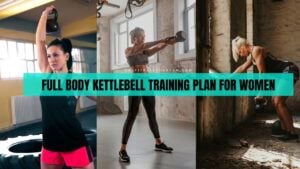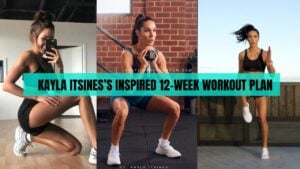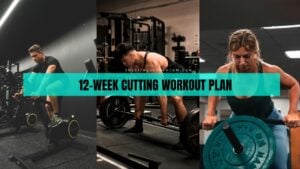Many fitness enthusiasts strive to build strength and muscle. But to achieve that goal, they’ll have to do more barbell exercises than dumbbells and machines. Barbells allow lifting maximum loads and ultimately help increase strength and mass.
You see maximum compound movements are performed with barbells as they recruit multiple muscles simultaneously. That’s one of the reasons why barbells are considered helpful for maximizing lifting ability.
Dumbbells and machines are great when it comes to safety and targeting specific muscles; however, if your goal is to level up strength and promote hypertrophy, you must perform barbell workouts slightly more.
In this article, I’ve shared an ultimate list of barbell exercises that can help you build a strong and beefy physique over time.
20 Best Barbell Exercises to Build Muscle and Strength
Here’s a list of all the exercises:
- Bench Press
- Overhead Press
- Close Grip Bench Press
- Barbell Front Raises
- Skull Crushers
- Conventional Deadlift
- Bent Over Row
- T-Bar Row
- Upright Row
- Biceps Curl
- Barbell Squat
- Sumo Deadlift
- Hip Thrust
- Romanian Deadlift
- Front Lunge
- Pendlay Row
- Barbell Jammer
- Landmine Press
- Barbell Rollout
- Meadows Row
From the back and chest to the legs and core, this article includes barbell exercises for every muscle group.
Whether you are a beginner or intermediate, you can integrate some of these exercises into your bodybuilding workout program.
1. Barbell Bench Press

| Force Type | Mechanics | Level | Muscles Worked |
|---|---|---|---|
| Push | Compound | Intermediate | Chest, Anterior Delt, & Triceps |
The barbell bench press is a compound exercise that primarily targets the pectoral muscles, builds a firm torso, and improves body composition.
A study has shown that the barbell bench press stimulates higher chest muscle activation than the dumbbell fly and suggests including it in the strength training program for muscle growth.1 A Comparison of Muscle Activation between Barbell Bench Press and Dumbbell Flyes in Resistance-Trained Males – Journal of Sports Science and Medicine
How to:
- Lie on a flat bench with your feet flat on the ground and your chest under the bar.
- Grab the bar firmly with your hands two times wider than hip-width apart.
- Keep your arms straight above your chest. That’s the starting position.
- Brace your core, inhale, and lower the bar toward your chest. Then, press the bar upward in a controlled manner until your arms are fully straight. This is your one repetition.
- Do four sets of 12, 10, 8, and 6 reps with heavier weights.
2. Barbell Overhead Press

| Force Type | Mechanics | Level | Muscles Worked |
|---|---|---|---|
| Push | Compound | Intermediate | Shoulder and Triceps |
The standing overhead press largely targets the deltoids. It also stimulates multiple muscles simultaneously, including the triceps and core.
How to:
- Put an appropriate weight into the bar and grab it firmly with your hands shoulder-width apart.
- Hold the bar in front of your shoulder and stand upright in the hip-width stance.
- Brace your abdominal muscles, inhale, and press the bar overhead until your arms are fully straight. That’s one rep!
- Suggested sets – four and repetitions – 10, 8, 6, and 4.
3. Barbell Front Raises
| Force Type | Mechanics | Level | Muscles Worked |
|---|---|---|---|
| Pull | Isolation | Beginner | Anterior Deltoid |
You can reinforce your shoulders more specifically with the barbell front raises.
The front raises to hit the anterior deltoid and help build stable and muscular shoulders.
Steps to do:
- Holding a bar in your hand with an under or overhand grip, stand in the normal stance and keep your arms straight in front of your hips.
- Raise the bar in front of you until your arms reach your chest height.
- Lower the bar to the start and repeat for the desired number of times.
4. Close Grip Bench Press
| Force Type | Mechanics | Level | Muscles Worked |
|---|---|---|---|
| Push | Isolation | Beginner | Triceps and Chest |
The barbell close grip bench press bolsters the triceps and helps build muscular and beefy arms.
How to:
- Lay down on a bench with your face up and chest under the bar.
- Grab the barbell firmly with your hands hip-width apart, and try to keep your elbows tucked at your sides.
- Brace your core, inhale, and press the bar upward toward the ceiling until your arms are fully extended above your chest.
- Lower the bar and then repeat for the desired number of times.
5. Skull Crushers

| Force Type | Mechanics | Level | Muscles Worked |
|---|---|---|---|
| Push | Isolation | Intermediate | Triceps |
The barbell skull crusher or French press is one of the isolation exercises that target the triceps’ long head and help develop solid arms.
It also strengthens the forearm and improves wrist mobility.
How to:
- Insert the appropriate weight into an EZ bar, grab firmly with your hands hip-width apart, and lie on the bench with your face up. Your palms should be facing upward.
- Keep your arms straight so the bar is above your head. That’s the start.
- Keep your elbows locked, lower your upper arms only behind your head, and then extend back to return to the start. It’s your one rep!
- You’ll feel the contraction in your triceps when you extend your arms.
- Do four sets of 12, 10, 8, and 6 reps.
6. Barbell Deadlift

| Force Type | Mechanics | Level | Muscles Worked |
|---|---|---|---|
| Pull | Compound | Intermediate | Integrated Full Body |
The deadlift is known as the king of all lifts. It strengthens multiple muscle groups throughout the body, especially the back and legs.
It helps level up strength, promote hypertrophy, and enhance overall fitness.
How to:
- Put an appropriate weight into the bar and keep it on the floor.
- Wear a gym belt for the safety of your lower back. And stand upright in the shoulder-width stance with your shin close to the bar.
- Push your hips back, bend your knees to lower yourself, and grab the bar firmly with an alternate grip. Please make sure your back is straight before you lift the bar. This is your starting position.
- Keep your abdominal muscles tight, inhale, and lift the bar with your full strength until your hips are extended.
- Hold in that position for a couple of seconds and then slowly lower the on the floor. That’s one rep.
- Do as many times as you can.
7. Barbell Bent Over Row

| Force Type | Mechanics | Level | Muscles Worked |
|---|---|---|---|
| Pull | Compound | Intermediate | Back and Core |
The bent-over barbell row is an excellent exercise that targets the latissimus dorsi, traps, and infraspinatus and helps build a sculpted and bigger back.
A study published by the Journal of Strength & Conditioning Research has shown that the bent-over row generates a higher muscle activation from the upper to lower back than other rowing exercises.2 Comparison of different rowing exercises: trunk muscle activation and lumbar spine motion, load, and stiffness – National Library of Medicine
So, if your goal is to develop a broader back, never miss performing this exercise.
How to:
- Holding a bar with an over or underhand grip, stand straight in the shoulder-width stance.
- Push your hips back and lean your torso forward while maintaining flat black. It’s your starting position.
- Pull the bar toward your stomach until you feel your back muscles contract.
- You can hold the bar for a few seconds before extending your elbows to return to the starting position.
- Do four sets of 12, 10, 8, and 6 reps.
8. Barbell T Rowing
| Force Type | Mechanics | Level | Muscles Worked |
|---|---|---|---|
| Pull | Isolation | Intermediate | Back and Core |
The T-bar barbell row targets the entire back muscles, from the lats to the erector spine, and facilitates muscle growth.
How to:
- Position one end of the bar in the corner and put the weight into another end.
- Grab a V-handle and put it under the bar so you can lift the weight.
- Stand between the bar with your feet slightly wider than hip-width apart.
- Lean your torso forward toward the floor with your eyes looking downward. It’s your starting position.
- Pull the bar up toward your belly until your lats are fully engaged.
- Hold there for a moment and then return your arms to the start.
- Do three to four sets of 8 to 12 repetitions each.
9. Barbell Upright Row

| Force Type | Mechanics | Level | Muscles Worked |
|---|---|---|---|
| Pull | Compound | Intermediate | Traps, Shoulder, & Biceps |
The barbell upright row engages multiple muscles simultaneously, particularly the delts and traps, and helps build a firm and aesthetic torso.
However, overdoing upright rows can increase the risk of shoulder injuries.
So, make sure to use lightweight and perform each rep in a slow and controlled fashion.
How to:
- Grab a bar with your hands slightly shorter than hip-width apart with an overhand grip.
- Stand upright with your chest up and arms straight in front of you and palms facing inward. It’s the set-up.
- Now, pull the bar up toward your neck as high as you can so your elbows point outward.
- You can hold at the top for a couple of seconds before lowering the bar to the starting point.
10. Barbell Curl

| Force Type | Mechanics | Level | Muscles Worked |
|---|---|---|---|
| Pull | Isolation | Beginner | Biceps |
The barbell curl elicits higher biceps muscle activation compared to the dumbbell curl and helps build strong arms.3 Differences in electromyographic activity of biceps brachii and brachioradialis while performing three variants of curl – Peer Journal.
A barbell also allows you to lift the maximum load compared to a dumbbell. And lifting heavy loads promotes strength and mass growth.
How to:
- Holding a bar with an underhand grip, stand straight in the normal stance.
- Keep your hands hip to shoulder width apart with your arms straight downward.
- Keep your elbows tucked at your sides and back straight. It’s your starting point.
- Curl your arms until you feel the contraction in your bicep muscles.
- Engaging your biceps, hold in that position for one to two seconds and then reverse the curl to complete your first repetition.
- You can complete three sets of 15, 12, and 10 repetitions for a better pump.
11. Barbell Squat

| Force Type | Mechanics | Level | Muscles Worked |
|---|---|---|---|
| Push | Compound | Intermediate | Quads, Glutes, & Core |
The barbell squat is one of the three big powerlifting lifts. It targets the entire lower body muscles, particularly the quads, and helps build powerful legs.
Many athletes and bodybuilders use barbell squats to enhance their athletic performance and encourage muscle growth.
How to:
- Insert the desired plates into the barbell.
- Place a thick sponge in the middle of the bar and wear a gym belt on your lower back for support.
- Hold the bar on the back of your shoulder and stand straight in the shoulder-width stance. That’s the starting position for you.
- Keep your abs tight, inhale, and slowly bend your knees to squat down until your glutes are parallel to the floor.
- Press into the ground with your feet and stand back until your knees are fully extended. It’s your one rep.
- You can complete three to five sets of 15 to 10 repetitions each for a great leg workout.
12. Barbell Lunge

| Force Type | Mechanics | Level | Muscles Worked |
|---|---|---|---|
| Push | Compound | Intermediate | Quads, Hamstrings, & Glutes |
The lunges are considered one of the best exercises for lower body muscle development.
It helps build strong quads, hamstrings, and glutes, improve hip mobility, build symmetrical legs, and enhance overall physical performance.
How to:
- Put the weights into the bar as per your strength and hold them on the back of your shoulders.
- Stand in the normal stance with your chest up and back straight.
- Keeping your abdominal muscles tight, take one large step forward with your right leg.
- Now, bend both your knees simultaneously until they are close or touch the floor.
- You can hold there for a moment before you extend your knees entirely. That’ll be your one repetition.
- Perform more on your inferior leg to fix muscle imbalance.
13. Sumo Deadlift

| Force Type | Mechanics | Level | Muscles Worked |
|---|---|---|---|
| Pull | Compound | Intermediate | Integrated Full Body |
The sumo deadlift is pretty similar to a conventional deadlift. The primary differences are the stance and range of motion.
During the sumo deadlift, your feet would be two times wider than hip-width apart and your toes pointing slightly outward.
Because of the different stances, your side quads and glutes are more engaged than the conventional deadlift.
14. Barbell Hip Thrust

| Force Type | Mechanics | Level | Muscles Worked |
|---|---|---|---|
| Push | Compound | Intermediate | Glute, Hamstrings, & Abs |
The hip thrust helps build strong, toned, and rounded glutes. It also targets the hamstrings, lower back, and abdominal muscles and builds a firm body.
How to:
- To perform a hip thrust, insert the desired weights into the bar and place a spongy, thick pad in the middle of the bar.
- Keep your upper back on a flat bench and put the bar on your hip.
- Bend your knees in front of you until they are in line with your hips. It’s the starting point.
- Thrust your hips upward as high as you can, pause for a second or two, and then lower your hips to complete your first repetition.
- Do three to four sets of ten to twelve reps each.
15. Barbell Romanian Deadlift
| Force Type | Mechanics | Level | Muscles Worked |
|---|---|---|---|
| Pull | Compound | Intermediate | Hamstrings, Quad, and Glutes |
Slightly different than the standard deadlift, the barbell RDL works more on the hamstrings than the quadriceps.
The Romanian deadlift also strengthens lower back muscles and builds up strong and flexible legs.
How to:
- First of all, put the weight plates into the bar as per your strength.
- Holding the bar with an alternate grip, stand upright in the normal position.
- Push your hips backward and lower the weight down until the bar is at your shin height. You can slightly bend your knees, but not like the standard deadlift.
- Extend your hips entirely to return to the starting position. It’s your one rep.
- Do three to four sets of 5 to 6 reps each.
16. Pendlay Row
| Force Type | Mechanics | Level | Muscles Worked |
|---|---|---|---|
| Pull | Isolation | Intermediate | Back, Rear Delt, & Core |
The Pendlay row is a high-intensity pull exercise that bolsters the back muscles increases strength, endurance, and power, and improves overall fitness.
It is slightly different than the bent-over row, as you are required to land the barbell on the floor during each rep.
How to:
- Grab a loaded barbell firmly with an overhand grip and stand in a shoulder-width stance.
- Bend your torso until your chest is parallel to the ground.
- Brace your core, keep your chest up, and maintain a neutral spine position. That’s the beginning.
- Driving your elbows, pull the bar until it touches your stomach, then lower it down until it touches the floor. Repeat.
17. Barbell Jammer
| Force Type | Mechanics | Level | Muscles Worked |
|---|---|---|---|
| Push | Compound | Advanced | Integrated Full Body |
The Jammer is an unpopular and effective exercise that must be included in your training schedule if you want to build muscle and lose weight.
It bolsters multiple muscles at once, including the legs, shoulder, chest, and triceps, and helps progress overall fitness.
How to:
- Place one end of the bar in a corner so that it stays intact, and put the suitable weights into another end.
- Grab the barbell with a neutral grip with your arms bent and hands in front of your chest.
- Stand in a shoulder-width stance with your torso slightly forward.
- Keep your knees straight and core tight, and maintain a flat back. That’s the start.
- Lower into a squat.
- Pushing your feet into the ground, drive your hips forward until your knees are fully extended.
- In the running motion, raise your heels off the ground and press the bar in front of your head simultaneously until your arms are fully straight. That’s one rep!
18. One-arm Landmine Press

| Force Type | Mechanics | Level | Muscles Worked |
|---|---|---|---|
| Push | Isolation | Intermediate | Shoulder and Chest |
The one-arm landmine press is a unilateral exercise that forges the shoulder and upper pecs simultaneously. You can do this to improve your strength imbalance and muscular symmetry.
It also burns significant calories and enhances cardiovascular fitness.
How to:
- Position one end of the bar in a corner so that it stays intact, and put the suitable weights into another end.
- Grab the barbell with one hand with the bar in front of your shoulder.
- Stand in a split stance with your torso slightly forward.
- Press the dumbbell diagonally until your arm is straight.
- Perform as many reps as needed on each side.
19. Barbell Rollout

| Force Type | Mechanics | Level | Muscles Worked |
|---|---|---|---|
| Roll | Compound | Intermediate | Core and Upper Body |
The barbell rollout is a core-strengthening exercise that provides decent stretches to your abdominal muscles.
It targets the rectus abdominis, transverse abdominis, and obliques and improves the appearance of your six-pack ab muscles.
How to:
- Insert a weight plate into each end of a barbell and lock them with pins.
- Sit on your knees with the barbell against you on the floor.
- Roll the bar in front of you until your abs are fully stretched.
- Return to the start and perform the desired reps.
20. Meadows Row
| Force Type | Mechanics | Level | Muscles Worked |
|---|---|---|---|
| Pull | Isolation | Intermediate | Back and Rear Delt |
The Meadows row is a one-arm rowing exercise that hits the lats and traps and helps build a bigger and more defined back. This movement was founded by the late John Meadows, a former IFBB bodybuilder and head coach of Mountain Dog.
How to:
- Insert the appropriate weight into one end of the bar and place the other end in the corner of the wall.
- Stand in a staggered stance with the front foot perpendicular to the bar.
- Hinge forward at your hips and grab the end of the barbell in your right hand.
- Drive your elbow at your side until you feel the good work in your lats.
- Pause and lower the bar to the start.
- Make sure you maintain proper form during the entire movement.
Can You Gain Muscle with Just Barbell Workouts?
Yes, you can build muscles with barbells only. Barbells allow you to lift maximum weights compared to the other types of equipment. Lifting heavy loads puts more stress on the muscles and activates fast-twitch muscle fibers (Type 2 muscle fibers), which are crucial in stimulating strength and hypertrophy.
However, you should also equally focus on dumbbell and machine exercises as they are equally responsible for achieving a strong and aesthetic physique.
Barbell Full Body Mass Gain Workouts PDF
You can also download a PDF of the barbell home workout routine to build mass and increase power.
References
- 1A Comparison of Muscle Activation between Barbell Bench Press and Dumbbell Flyes in Resistance-Trained Males – Journal of Sports Science and Medicine
- 2Comparison of different rowing exercises: trunk muscle activation and lumbar spine motion, load, and stiffness – National Library of Medicine
- 3






